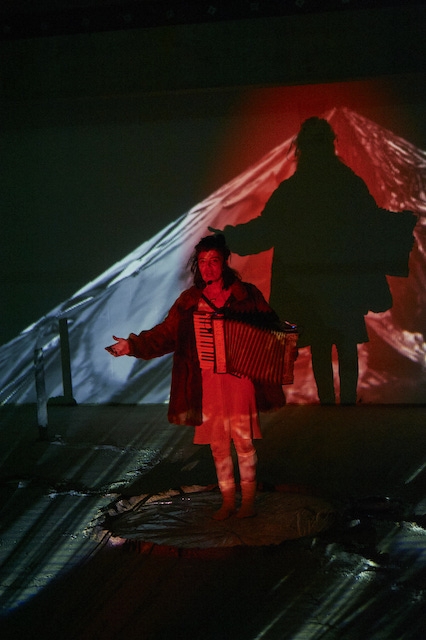Late one winter afternoon, in an incongruously shabby building on a London street lined with bluechip galleries and designer clothes shops, I witnessed the end of the world. Or rather, given that this was a night of experimental performances organised by an art institution, a representation of it. The interior of the venue resembled a squat-party in a building site – bare concrete floors, a Portaloo in the corner – populated by a leather- and spandex-wearing crowd resembling extras in Hackers (1995). Chatting with a friend before the headline act, I rolled my eyes at the derelict venue, expressed judgemental opinions about people’s footwear, and resented having to hang around in the cold. A press release about the headline act cited primordial voids, K-holes and an ominous return to ‘the end’. Which will likely translate to fits of screaming, I thought, hoping that I would be wrong.
A crowd gathered beside the Portaloo, next to a hole in the floor from which came grinding, clanking sounds. We were ushered down rickety scaffolding into a dark basement in which a woman in black, head bowed, was dragging a length of scaffolding in circles along the floor and hitting it against the walls. Four people stood at a table nearby, armed with a black, plastic crate, an old desktop mac, a battered drum pad and other salvagedlooking bits and bobs. Thumping kick-drums, walls of distortion and jungle beats paired with infernal red glows and spasmodic strobe lights. One musician was wearing a headlamp, another a white veil. A man in a white shirt read a story about a planet poisoned by corporate greed and technological hubris. Projected against the far wall were photographs of blighted landscapes and ruined cities, the images sooty and blurred like dodgy photocopies from a school textbook. ‘But we don’t need history lessons,’ I thought self-righteously, ‘the world is on fire!’
The performances drew parallels between the so-called Winter of Discontent of 1978–79, marked by crippling strikes and the fragmentation of the left, and the present day. But by recapitulating the radical cultural forms that flourished in the years around the election of Margaret Thatcher, the apocalypticindustrial aesthetic felt outdated (and not just because bushfires, desertification and acidifying oceans feel like more present threats to the world’s future than those that loomed 40 years ago). In 1976, at Throbbing Gristle’s first performance at London’s ICA, Genesis P-Orridge declared that the gig would be about the ‘postbreakdown of civilisation’ and described a bleak landscape informed by the looming possibility of a nuclear war. These grim prophetic visions, replete with references to serial killers and death camps, were not only nihilistic but sought to foment revolution. I couldn’t feel the same way about the spectacle playing out in front of me, which felt instead like a tribute to iconoclasts and apocalypses past. A musician was bashing a chain against a bucket and, as I had feared, the screaming started. This was my cue to leave.
Heading back into the night, I tried to make sense of my frustration. Every generation has its own version of civilisational collapse – nuclear winter, global pandemic, ecological disaster – and perhaps all end-times feel at once impossible and inevitable, a future we are powerless to avoid and so doomed to act out imaginatively. But the end isn’t nigh. It’s already here, only playing out over a longer duration and moving in ways sometimes invisible to those who, like me, have been protected by privilege and geography from bushfire and flood. Which begs the question: how can art and music figure this accelerating crisis?
In the Book of Revelation, the end of the world brings not only destruction but knowledge: ‘here is wisdom’. These days, it feels as if we are becoming more aware of the catastrophic consequences of inaction even as we fail to act on that awareness. The art that best captures the climate crisis foregrounds this paradox by accepting that human activity is making our planet hostile to life, acknowledging how difficult it is to process that reality and, by extension, how easily such knowledge is repressed: the first step towards effecting change is to highlight our devastating complacency. In the opera Sun & Sea (Marina) by Rugile· Barzdžiukaite·, Vaiva Grainyte· and Lina Lapelyte·, staged at the Lithuanian Pavilion at last year’s Venice Biennale, bathers on a beach sing about dead coral reefs, erupting volcanoes, sun cream and boredom. At one point, in a leisurely refrain, they sing that “everything is fine”. The melody is gentle, the irony anything but. It depicts a scenario both more plausible and more imminent than cataclysmic war or divine punishment: that we sit back and watch the end of the world play out in front of our eyes.
Patrick Langley is a critic and novelist based in London
From the March 2020 issue of ArtReview
